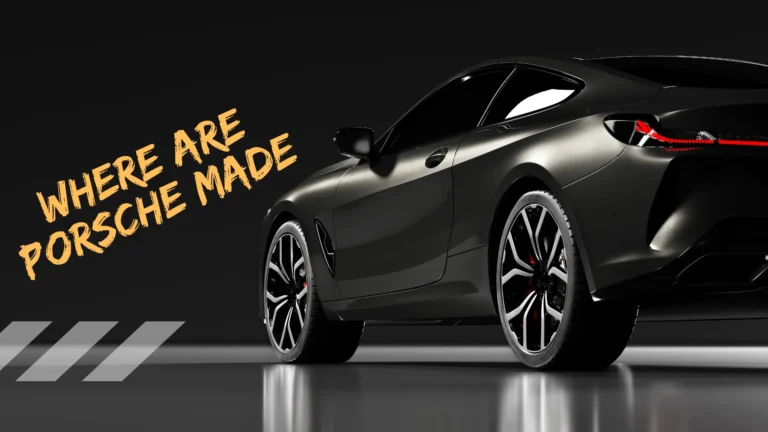Where Is Mazda Made

Mazda, a well-known Japanese automaker, has a strong global presence, with manufacturing plants in multiple regions worldwide. The company strategically places its production facilities to cater to different markets, ensuring efficiency and quality in its vehicle manufacturing. In this article, we explore where Mazda vehicles are made, detailing their manufacturing plants in Japan, North America, Asia, and Europe.
Mazda’s Manufacturing Origins in Japan
Mazda’s legacy began in Japan, where the company continues to maintain its most significant production operations. The brand’s headquarters and primary factories are located in Hiroshima and Hofu, producing a vast range of Mazda vehicles.
Hiroshima Headquarters and Facilities
Mazda’s global headquarters is located in Hiroshima, Japan. The Hiroshima facility plays a vital role in the company’s operations, serving as both a manufacturing hub and a research and development center. This plant produces a variety of Mazda models, including the Mazda6, CX-30, CX-9, MX-30, and the iconic MX-5 (Miata).
The Hiroshima plant is also known for its technological advancements in automotive production. It integrates innovative techniques such as Skyactiv technology, which enhances fuel efficiency and performance. As Mazda’s main plant, it plays a crucial role in the company’s global supply chain.
Hofu Plant in Yamaguchi Prefecture
The Hofu plant, located in Yamaguchi Prefecture, complements Mazda’s Hiroshima facility. It is responsible for manufacturing several models, including the Mazda2, Mazda3, Mazda6, CX-5, CX-60, CX-80, and CX-90.
This plant is known for its precision manufacturing processes and high-quality assembly lines, ensuring that Mazda vehicles meet stringent safety and performance standards. The facility is equipped with modern robotic systems and automated production techniques to enhance efficiency.
Expansion into North America
Mazda has expanded its manufacturing operations into North America to cater to its growing customer base in the region. The company operates production plants in the United States and Mexico, allowing it to produce vehicles closer to its key markets.
Mazda Toyota Manufacturing USA (MTMUS) in Alabama
To strengthen its presence in the U.S., Mazda partnered with Toyota to establish the Mazda Toyota Manufacturing USA (MTMUS) plant in Huntsville, Alabama. This facility, which became operational in 2021, produces both Toyota and Mazda models.
One of the key vehicles produced at this plant is the Mazda CX-50, a compact crossover SUV designed for the North American market. The plant has a production capacity of approximately 300,000 vehicles annually, allowing Mazda to meet growing demand efficiently. The facility also features state-of-the-art production techniques and quality control measures to ensure high standards.
Operations in Mexico
Mazda has a strong presence in Mexico, with a manufacturing plant in Salamanca, Guanajuato. This facility, which began operations in 2014, produces several Mazda models, including the Mazda2, Mazda3, CX-3, and CX-30.
The Salamanca plant serves as a critical manufacturing hub for the North and South American markets. It benefits from Mexico’s strategic location and trade agreements, allowing Mazda to distribute vehicles efficiently across the continent. The facility also adheres to Mazda’s strict quality control standards, ensuring that the vehicles meet global safety and performance expectations.
Presence in Asia
Beyond Japan, Mazda has expanded its manufacturing presence across Asia, leveraging joint ventures and production facilities in key markets like China and Thailand.
Collaborative Ventures in China
China is one of the largest automotive markets in the world, and Mazda has established a strong presence through a joint venture with Changan Automobile. The joint company, known as Changan Mazda Automobile (CMA), operates a manufacturing plant in Nanjing.
This facility produces various Mazda models, including the Mazda3, CX-30, CX-5, CX-50, and EZ-6. The plant is focused on meeting the high demand for Mazda vehicles in China while maintaining the company’s commitment to quality and innovation.
Production Facilities in Thailand
Mazda also has a significant manufacturing presence in Thailand through a joint venture with Ford, known as AutoAlliance Thailand (AAT). The Rayong plant, operated under this venture, produces vehicles such as the Mazda2, Mazda3, CX-3, and CX-30.
The Thailand facility plays a key role in Mazda’s strategy to serve the Southeast Asian market. With advanced production techniques and a focus on fuel-efficient technologies, the plant supports Mazda’s commitment to sustainability and innovation.
European Market Strategy
Unlike other major regions, Mazda does not have dedicated manufacturing plants in Europe. Instead, the company relies on local assembly and distribution networks to serve European customers.
Mazda’s strategy in Europe focuses on importing vehicles from its manufacturing plants in Japan, North America, and Asia while ensuring that they meet European regulations and consumer preferences. The company has established strong partnerships with local distributors and assembly operations to streamline the supply chain and maintain vehicle availability.
Conclusion
Mazda’s global manufacturing strategy reflects its commitment to producing high-quality vehicles tailored to regional markets. With major production facilities in Japan, North America, and Asia, Mazda ensures efficiency, innovation, and adherence to its brand values.
By leveraging strategic partnerships and advanced manufacturing techniques, Mazda continues to be a leader in the automotive industry, offering vehicles that combine performance, reliability, and cutting-edge technology.





